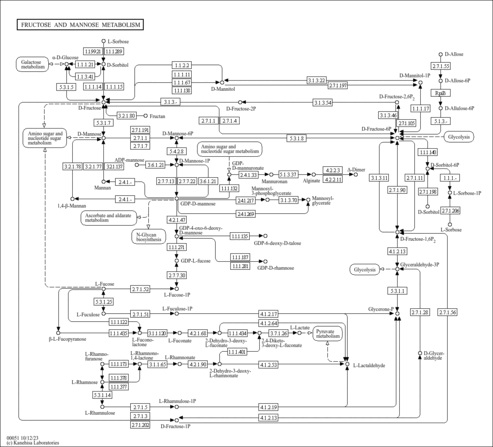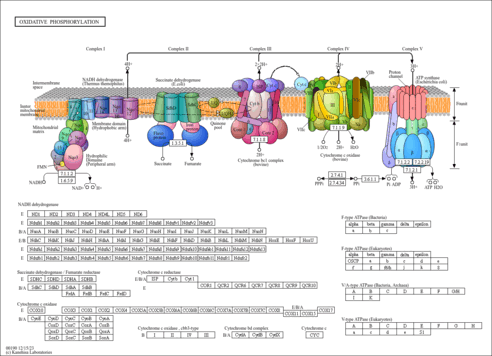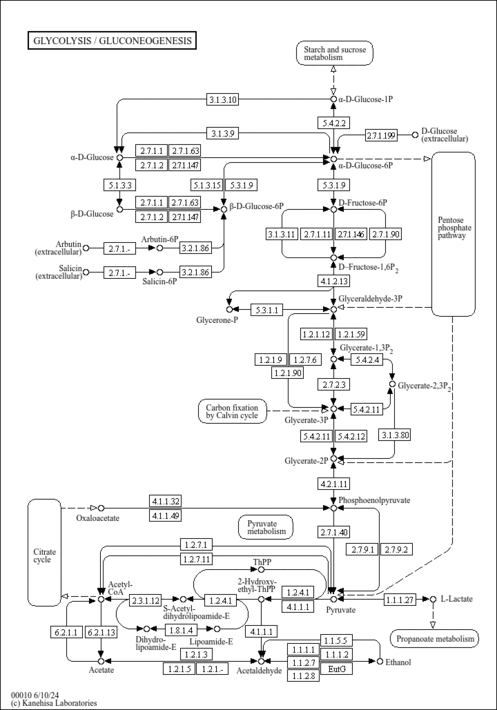| Derivative Name / Structure | SMILES | Kovats RI Value | Column Type | Reference |
|---|
| Glyceraldehyde 3-phosphate,1TMS,isomer #1 | C[Si](C)(C)O[C@@H](C=O)COP(=O)(O)O | 1603.8 | Semi standard non polar | 33892256 |
| Glyceraldehyde 3-phosphate,1TMS,isomer #2 | C[Si](C)(C)OP(=O)(O)OC[C@@H](O)C=O | 1595.6 | Semi standard non polar | 33892256 |
| Glyceraldehyde 3-phosphate,1TMS,isomer #3 | C[Si](C)(C)OC=C(O)COP(=O)(O)O | 1689.7 | Semi standard non polar | 33892256 |
| Glyceraldehyde 3-phosphate,2TMS,isomer #1 | C[Si](C)(C)O[C@@H](C=O)COP(=O)(O)O[Si](C)(C)C | 1670.3 | Semi standard non polar | 33892256 |
| Glyceraldehyde 3-phosphate,2TMS,isomer #1 | C[Si](C)(C)O[C@@H](C=O)COP(=O)(O)O[Si](C)(C)C | 1570.8 | Standard non polar | 33892256 |
| Glyceraldehyde 3-phosphate,2TMS,isomer #1 | C[Si](C)(C)O[C@@H](C=O)COP(=O)(O)O[Si](C)(C)C | 2048.5 | Standard polar | 33892256 |
| Glyceraldehyde 3-phosphate,2TMS,isomer #2 | C[Si](C)(C)OC=C(COP(=O)(O)O)O[Si](C)(C)C | 1751.8 | Semi standard non polar | 33892256 |
| Glyceraldehyde 3-phosphate,2TMS,isomer #2 | C[Si](C)(C)OC=C(COP(=O)(O)O)O[Si](C)(C)C | 1715.5 | Standard non polar | 33892256 |
| Glyceraldehyde 3-phosphate,2TMS,isomer #2 | C[Si](C)(C)OC=C(COP(=O)(O)O)O[Si](C)(C)C | 2483.5 | Standard polar | 33892256 |
| Glyceraldehyde 3-phosphate,2TMS,isomer #3 | C[Si](C)(C)OP(=O)(OC[C@@H](O)C=O)O[Si](C)(C)C | 1635.3 | Semi standard non polar | 33892256 |
| Glyceraldehyde 3-phosphate,2TMS,isomer #3 | C[Si](C)(C)OP(=O)(OC[C@@H](O)C=O)O[Si](C)(C)C | 1587.8 | Standard non polar | 33892256 |
| Glyceraldehyde 3-phosphate,2TMS,isomer #3 | C[Si](C)(C)OP(=O)(OC[C@@H](O)C=O)O[Si](C)(C)C | 1945.7 | Standard polar | 33892256 |
| Glyceraldehyde 3-phosphate,2TMS,isomer #4 | C[Si](C)(C)OC=C(O)COP(=O)(O)O[Si](C)(C)C | 1752.3 | Semi standard non polar | 33892256 |
| Glyceraldehyde 3-phosphate,2TMS,isomer #4 | C[Si](C)(C)OC=C(O)COP(=O)(O)O[Si](C)(C)C | 1634.1 | Standard non polar | 33892256 |
| Glyceraldehyde 3-phosphate,2TMS,isomer #4 | C[Si](C)(C)OC=C(O)COP(=O)(O)O[Si](C)(C)C | 2203.5 | Standard polar | 33892256 |
| Glyceraldehyde 3-phosphate,3TMS,isomer #1 | C[Si](C)(C)O[C@@H](C=O)COP(=O)(O[Si](C)(C)C)O[Si](C)(C)C | 1715.1 | Semi standard non polar | 33892256 |
| Glyceraldehyde 3-phosphate,3TMS,isomer #1 | C[Si](C)(C)O[C@@H](C=O)COP(=O)(O[Si](C)(C)C)O[Si](C)(C)C | 1645.3 | Standard non polar | 33892256 |
| Glyceraldehyde 3-phosphate,3TMS,isomer #1 | C[Si](C)(C)O[C@@H](C=O)COP(=O)(O[Si](C)(C)C)O[Si](C)(C)C | 1746.4 | Standard polar | 33892256 |
| Glyceraldehyde 3-phosphate,3TMS,isomer #2 | C[Si](C)(C)OC=C(COP(=O)(O)O[Si](C)(C)C)O[Si](C)(C)C | 1792.8 | Semi standard non polar | 33892256 |
| Glyceraldehyde 3-phosphate,3TMS,isomer #2 | C[Si](C)(C)OC=C(COP(=O)(O)O[Si](C)(C)C)O[Si](C)(C)C | 1686.2 | Standard non polar | 33892256 |
| Glyceraldehyde 3-phosphate,3TMS,isomer #2 | C[Si](C)(C)OC=C(COP(=O)(O)O[Si](C)(C)C)O[Si](C)(C)C | 2059.2 | Standard polar | 33892256 |
| Glyceraldehyde 3-phosphate,3TMS,isomer #3 | C[Si](C)(C)OC=C(O)COP(=O)(O[Si](C)(C)C)O[Si](C)(C)C | 1803.1 | Semi standard non polar | 33892256 |
| Glyceraldehyde 3-phosphate,3TMS,isomer #3 | C[Si](C)(C)OC=C(O)COP(=O)(O[Si](C)(C)C)O[Si](C)(C)C | 1702.0 | Standard non polar | 33892256 |
| Glyceraldehyde 3-phosphate,3TMS,isomer #3 | C[Si](C)(C)OC=C(O)COP(=O)(O[Si](C)(C)C)O[Si](C)(C)C | 1919.2 | Standard polar | 33892256 |
| Glyceraldehyde 3-phosphate,4TMS,isomer #1 | C[Si](C)(C)OC=C(COP(=O)(O[Si](C)(C)C)O[Si](C)(C)C)O[Si](C)(C)C | 1833.6 | Semi standard non polar | 33892256 |
| Glyceraldehyde 3-phosphate,4TMS,isomer #1 | C[Si](C)(C)OC=C(COP(=O)(O[Si](C)(C)C)O[Si](C)(C)C)O[Si](C)(C)C | 1740.3 | Standard non polar | 33892256 |
| Glyceraldehyde 3-phosphate,4TMS,isomer #1 | C[Si](C)(C)OC=C(COP(=O)(O[Si](C)(C)C)O[Si](C)(C)C)O[Si](C)(C)C | 1843.8 | Standard polar | 33892256 |
| Glyceraldehyde 3-phosphate,1TBDMS,isomer #1 | CC(C)(C)[Si](C)(C)O[C@@H](C=O)COP(=O)(O)O | 1843.7 | Semi standard non polar | 33892256 |
| Glyceraldehyde 3-phosphate,1TBDMS,isomer #2 | CC(C)(C)[Si](C)(C)OP(=O)(O)OC[C@@H](O)C=O | 1835.1 | Semi standard non polar | 33892256 |
| Glyceraldehyde 3-phosphate,1TBDMS,isomer #3 | CC(C)(C)[Si](C)(C)OC=C(O)COP(=O)(O)O | 1919.6 | Semi standard non polar | 33892256 |
| Glyceraldehyde 3-phosphate,2TBDMS,isomer #1 | CC(C)(C)[Si](C)(C)O[C@@H](C=O)COP(=O)(O)O[Si](C)(C)C(C)(C)C | 2088.0 | Semi standard non polar | 33892256 |
| Glyceraldehyde 3-phosphate,2TBDMS,isomer #1 | CC(C)(C)[Si](C)(C)O[C@@H](C=O)COP(=O)(O)O[Si](C)(C)C(C)(C)C | 2008.5 | Standard non polar | 33892256 |
| Glyceraldehyde 3-phosphate,2TBDMS,isomer #1 | CC(C)(C)[Si](C)(C)O[C@@H](C=O)COP(=O)(O)O[Si](C)(C)C(C)(C)C | 2265.9 | Standard polar | 33892256 |
| Glyceraldehyde 3-phosphate,2TBDMS,isomer #2 | CC(C)(C)[Si](C)(C)OC=C(COP(=O)(O)O)O[Si](C)(C)C(C)(C)C | 2150.4 | Semi standard non polar | 33892256 |
| Glyceraldehyde 3-phosphate,2TBDMS,isomer #2 | CC(C)(C)[Si](C)(C)OC=C(COP(=O)(O)O)O[Si](C)(C)C(C)(C)C | 2132.4 | Standard non polar | 33892256 |
| Glyceraldehyde 3-phosphate,2TBDMS,isomer #2 | CC(C)(C)[Si](C)(C)OC=C(COP(=O)(O)O)O[Si](C)(C)C(C)(C)C | 2634.7 | Standard polar | 33892256 |
| Glyceraldehyde 3-phosphate,2TBDMS,isomer #3 | CC(C)(C)[Si](C)(C)OP(=O)(OC[C@@H](O)C=O)O[Si](C)(C)C(C)(C)C | 2059.6 | Semi standard non polar | 33892256 |
| Glyceraldehyde 3-phosphate,2TBDMS,isomer #3 | CC(C)(C)[Si](C)(C)OP(=O)(OC[C@@H](O)C=O)O[Si](C)(C)C(C)(C)C | 2013.5 | Standard non polar | 33892256 |
| Glyceraldehyde 3-phosphate,2TBDMS,isomer #3 | CC(C)(C)[Si](C)(C)OP(=O)(OC[C@@H](O)C=O)O[Si](C)(C)C(C)(C)C | 2153.6 | Standard polar | 33892256 |
| Glyceraldehyde 3-phosphate,2TBDMS,isomer #4 | CC(C)(C)[Si](C)(C)OC=C(O)COP(=O)(O)O[Si](C)(C)C(C)(C)C | 2187.8 | Semi standard non polar | 33892256 |
| Glyceraldehyde 3-phosphate,2TBDMS,isomer #4 | CC(C)(C)[Si](C)(C)OC=C(O)COP(=O)(O)O[Si](C)(C)C(C)(C)C | 2096.9 | Standard non polar | 33892256 |
| Glyceraldehyde 3-phosphate,2TBDMS,isomer #4 | CC(C)(C)[Si](C)(C)OC=C(O)COP(=O)(O)O[Si](C)(C)C(C)(C)C | 2418.5 | Standard polar | 33892256 |
| Glyceraldehyde 3-phosphate,3TBDMS,isomer #1 | CC(C)(C)[Si](C)(C)O[C@@H](C=O)COP(=O)(O[Si](C)(C)C(C)(C)C)O[Si](C)(C)C(C)(C)C | 2332.7 | Semi standard non polar | 33892256 |
| Glyceraldehyde 3-phosphate,3TBDMS,isomer #1 | CC(C)(C)[Si](C)(C)O[C@@H](C=O)COP(=O)(O[Si](C)(C)C(C)(C)C)O[Si](C)(C)C(C)(C)C | 2210.1 | Standard non polar | 33892256 |
| Glyceraldehyde 3-phosphate,3TBDMS,isomer #1 | CC(C)(C)[Si](C)(C)O[C@@H](C=O)COP(=O)(O[Si](C)(C)C(C)(C)C)O[Si](C)(C)C(C)(C)C | 2087.9 | Standard polar | 33892256 |
| Glyceraldehyde 3-phosphate,3TBDMS,isomer #2 | CC(C)(C)[Si](C)(C)OC=C(COP(=O)(O)O[Si](C)(C)C(C)(C)C)O[Si](C)(C)C(C)(C)C | 2390.6 | Semi standard non polar | 33892256 |
| Glyceraldehyde 3-phosphate,3TBDMS,isomer #2 | CC(C)(C)[Si](C)(C)OC=C(COP(=O)(O)O[Si](C)(C)C(C)(C)C)O[Si](C)(C)C(C)(C)C | 2274.9 | Standard non polar | 33892256 |
| Glyceraldehyde 3-phosphate,3TBDMS,isomer #2 | CC(C)(C)[Si](C)(C)OC=C(COP(=O)(O)O[Si](C)(C)C(C)(C)C)O[Si](C)(C)C(C)(C)C | 2329.7 | Standard polar | 33892256 |
| Glyceraldehyde 3-phosphate,3TBDMS,isomer #3 | CC(C)(C)[Si](C)(C)OC=C(O)COP(=O)(O[Si](C)(C)C(C)(C)C)O[Si](C)(C)C(C)(C)C | 2410.3 | Semi standard non polar | 33892256 |
| Glyceraldehyde 3-phosphate,3TBDMS,isomer #3 | CC(C)(C)[Si](C)(C)OC=C(O)COP(=O)(O[Si](C)(C)C(C)(C)C)O[Si](C)(C)C(C)(C)C | 2294.0 | Standard non polar | 33892256 |
| Glyceraldehyde 3-phosphate,3TBDMS,isomer #3 | CC(C)(C)[Si](C)(C)OC=C(O)COP(=O)(O[Si](C)(C)C(C)(C)C)O[Si](C)(C)C(C)(C)C | 2248.7 | Standard polar | 33892256 |
| Glyceraldehyde 3-phosphate,4TBDMS,isomer #1 | CC(C)(C)[Si](C)(C)OC=C(COP(=O)(O[Si](C)(C)C(C)(C)C)O[Si](C)(C)C(C)(C)C)O[Si](C)(C)C(C)(C)C | 2592.2 | Semi standard non polar | 33892256 |
| Glyceraldehyde 3-phosphate,4TBDMS,isomer #1 | CC(C)(C)[Si](C)(C)OC=C(COP(=O)(O[Si](C)(C)C(C)(C)C)O[Si](C)(C)C(C)(C)C)O[Si](C)(C)C(C)(C)C | 2402.3 | Standard non polar | 33892256 |
| Glyceraldehyde 3-phosphate,4TBDMS,isomer #1 | CC(C)(C)[Si](C)(C)OC=C(COP(=O)(O[Si](C)(C)C(C)(C)C)O[Si](C)(C)C(C)(C)C)O[Si](C)(C)C(C)(C)C | 2243.6 | Standard polar | 33892256 |


